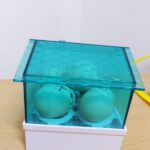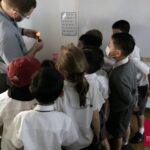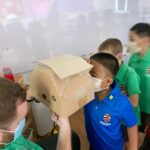This term, Year 2 Science lessons have been on the theme of ‘Animals Including Humans’. We have been looking at growth and survival of different animals around the world and part of our learning has been about which animals lay eggs and which give birth to live young. We have also been focusing on what all animals need to survive.
To really bring the learning to life (literally), we decided to try to hatch our own chicks from eggs.
We first marked up the eggs with an ‘X’ on one side and an ‘O’ on the other to keep track of which way we had turned them daily as they developed. We then set our incubator to 38.1℃ and added a little water to bring up the humidity – perfect conditions for healthy chicks to develop!
Whilst inside the incubator, we check on the chicks’ progress daily by using a method called ‘candling’, in which we hold a torch up to the egg to see the silhouette of the embryo. We were amazed at how we could see different parts of the chicks growing day by day.
We had expected the arrival of our chicks around approximately day 21, as is the average gestation period, but at day 19, we began to hear some chirping and observed a small crack in one of the eggs so we hurried to prepare a comfy nesting box for our new baby with everything we had learnt it would need to be happy and healthy. Unfortunately, this chick had decided to hatch from the wrong side of the egg and being premature, needed extra help and care, therefore is now being looked after away from school where it can get specialist treatment.
A few days later, we arrived at school to find another little surprise waiting for us. A happy, healthy chick had hatched successfully during the night and was sitting, chirping away in the incubator. After allowing it time to settle, we got to know the little hen and moved her into the nesting box. Being so small and being all alone, she was being very noisy, calling out for other chickens so we decided to let her go and live with our first chick, where she would have lots of friends to play with.
The next Monday, we arrived to 4 more chicks, this time slightly older and sturdier, which we have been given to look after. We have been learning all about how to care for them: preparing their food, bedding and fresh water daily. We decided that their nesting box was a little small now for these chicks, which are getting bigger by the day, so we decided to design a more complex modular home for them. We all drew our own annotated designs and then came together to focus on our learner profile of the week and be reflective. We decided on the most appropriate parts of our design and then split into small groups to build different sections of their new home, including: an eating/drinking room, an open area to play, a scratching and pecking zone to satisfy their chicken impulses to dig and make a mess and a nice cozy nesting area.
We have thoroughly enjoyed seeing the process of life being created, relating it to our science learning and especially the playtimes and interactions we can have with them each day, which has been both exciting and relaxing. Their presence has given us so many fantastic learning opportunities and taught us to be more responsible and caring individuals.



































